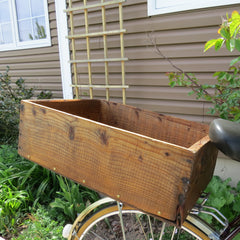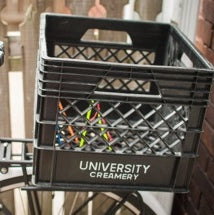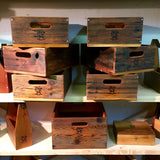Bicycle boxes and trunks have been gaining in popularity for a while now. They are a practical solution to the need to carry goods and essential items when travelling by bicycle. They were standard fare on the early “cargo” bicycles of the early to mid twenty century for moving items like groceries and mail, and as likely to be installed on a front rack as on the rear. Up until recently, the practical and thrifty model was the milk crate, which in all honestly is an ideal item for transporting goods in this way.
 |
 |
| FreeLander Bicycles | Photo Courtesy of Bike Pittsburgh |
However the recent increase in popularity of commuting by bicycle and using it as a primary means of transportation, at a more fashion conscious time, has lead to the desire for something a little more aesthetically appealing and original. Coupled with increasing environmental awareness, up-cycled items and new or vintage wooden crates have become the items of choice. A box, crate or trunk is of course for the average bicyclist, in lieu of a full on cargo bike designed specifically transporting children or large or commercial loads.
I personally like the idea of crates and boxes. Although I have done it on occasion, I do not like to ride with bags strapped to my shoulders of any configuration. Baskets are great but just not my style. And I prefer panniers of the fabric type more for touring than commuting (more on hard shell “panniers” in a future post).
Choices for a rear, top-rack, container are many. The most common/available and most desirable from my standpoint can be grouped into 1. Wooden crates, 2. Metal picnic tins and 3. Other items that were intended to carry a small to medium load with their original purpose. These include hardshell luggage vanities, lunch boxes, etc.
Wooden Boxes
 These are by far the most common and sought after. Wood as a natural, renewable material is very appealing both to look at and use. Many who choose wood crates also do so for the vintage element often seeking out one with a producer or regional logo or text emblazoned on the side or end. My heart soars when I see something repurposed rather than abandoned and discarded. There are also new, hand crafted wooden boxes, often with slated sides as opposed to solid available from merchants on ETSY and others. The benefits of going new is again the material, look, ease to work with (install), but also the variety in choice and availability.
These are by far the most common and sought after. Wood as a natural, renewable material is very appealing both to look at and use. Many who choose wood crates also do so for the vintage element often seeking out one with a producer or regional logo or text emblazoned on the side or end. My heart soars when I see something repurposed rather than abandoned and discarded. There are also new, hand crafted wooden boxes, often with slated sides as opposed to solid available from merchants on ETSY and others. The benefits of going new is again the material, look, ease to work with (install), but also the variety in choice and availability.
I do have some concerns about using wooden crates however, especially the up-cycled ones. Firstly, it needs to be in sound condition. Damage to the crate may only add to the character and atheistic, but if the damage compromises the structural integrity, stay clear. Some may be repairable, but that needs to be added into the cost and time it will take to get it ready. Also one needs to have, or find, the available resources and skills. Most notable and often however, a wooden box is discovered and no thought is given to whether it is suitable for a bicycle.
Often the size and weight of a crate can make it dangerous and uncomfortable. The size and construction of the box determines it weight and the potential weight of it contents. Thicker wood, hardwood, heavier fasteners all contribute to the weight. Many crates I have seen for sale are simply too heavy. Weight varies, but 5-10 lb. (2.25-4.5 kg) is average. If size and weight are too great, it increases the “sway” a rider will feel as they pedal, especially out of the saddle. If it is too long, it will extend beyond the rear carrier too far and/or be pushed up against the rider’s saddle and “seat”. If the size is generally too large, the potential weight it can hold may compromise the rack or its connection to the frame, especially if there is sway. For me, it is the location on the rack, against my seat (it sometime feels as if you’re sitting on a wooden rail,) that makes large crates so undesirable. There is also the issue of scale; some large crates simply look odd on bicycles.
Smaller crates however are a joy. Light, low sided, not too long and made of a softwood such as spruce or pine, or a thinner hardwood fit this criterium. Even though it may be shorter in the sides, you can still carry a significant amount of cargo as it will extend up slightly past the sides and can be lashed down with a net or shock-cords. Smaller vintage crates negate all the concerns mentioned above. Best of all, although new materials are being used, is a crate designed specifically for bicycles. Although they will generally come at a greater cost, you are helping someone pursue their passion and you are getting a well-made, hand-made, beautiful, practical and purposefully designed crate.
 The only drawbacks to ideally suited crate as I see it, is the open top and security. Contents must be secured to prevent loss. More significantly may be their exposure to the elements. Many will use a waterproof bag of some sort to put their goods in before placing them in the crate. Others will make, or try to find, some type of cover or lid. This may or may not be possible or even entirely water proof in the end. Also, without a locking lid, leaving anything in the crate, is not advised.
The only drawbacks to ideally suited crate as I see it, is the open top and security. Contents must be secured to prevent loss. More significantly may be their exposure to the elements. Many will use a waterproof bag of some sort to put their goods in before placing them in the crate. Others will make, or try to find, some type of cover or lid. This may or may not be possible or even entirely water proof in the end. Also, without a locking lid, leaving anything in the crate, is not advised.
Maintenance should be a consideration of any item you own. Wooden crates are best protected with an annual application of tung oil or some other similar protectant that is comparable with the existing finish.
The cost of both new and up-cycled crates varies greatly from $30-$100 USD or $45-$140 CDN at time of posting. At times there can be just as much, or more, work put in restoring a crate as compared to building one with new materials. In the vintage category, the rarity, condition and iconic value will also be factored into price.
Maybe this is more than you wished for or needed to know, but hopefully you will now be able to choose the perfect wooden crate for your bicycle. But wait! There are other options. The next instalment will look at two alternative to wooden crates: the hard shelled luggage vanity and the metal picnic box. It will conclude with installation considerations for all three types.
Take care, Daryl

2 comments
Thanks Rob. I am equally glad to know of another person with a passion for restoring vintage bicycles. I have had similar experiences with Landfill Managers. Some are very supportive of what were are doing, others not at all. I wish there was a municipal policy that applied to bicycles whereby they were separated from the other hard trash for a period to allow restorationists to salvage what they can. Cheers, Daryl
Love your website. I am ecstatic to find a supplier for old CCM parts. I have 6, 3 rideable, and 3 I’m restoring. I usually try to make do with various parts I find from abandoned bikes and from the landfill, but I have to be careful there or the garbage officials will make me put back anything I think I can re-use. For now I’ve ordered two 47-571 tires, but when I’ve saved some dough I’ll get some leather grips and perhaps the rubber peddles if you have them.
Cheers,
Rob